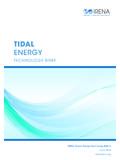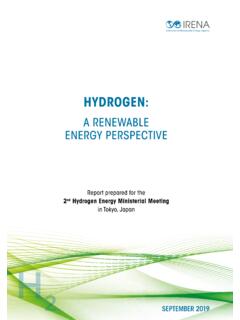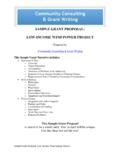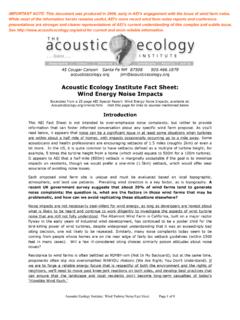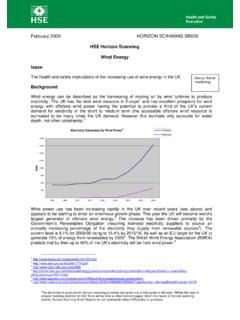Transcription of Renewable Energy Cost Analysis: Wind Power
1 Renewable Energy TECHNOLOGIES: cost analysis SERIESJune 2012 wind Power Issue 5/5 International Renewable Energy AgencyIRENAIRENA woRkINg pAg pAAg ppERVolume 1: Power SectorAcknowledgement This paper was prepared by the IRENA Secretariat. The paper benefitted from an internal IRENA review, as well as valuable comments and guidance from Stefan Gs nger (WWEA), Steve Sawyer (GWEC) and Cassia Simons Januario (VESTAS).For further information or to provide feedback, please contact Michael Taylor, IRENA Innovationand Technology Centre, Robert-Schuman-Platz 3, 53175 Bonn, Germany; working paper is available for download from (c) IRENA 2012 Unless otherwise indicated, material in this publication may be used freely, shared or reprinted,but acknowledgement is IRENAThe International Renewable Energy Agency (IRENA) is an intergovernmental organisation dedicated to Renewable accordance with its Statute, IRENA's objective is to "promote the widespread and increased adoption and the sustainable use of all forms of Renewable Energy ".
2 This concerns all forms of Energy produced from Renewable sources in a sustainable manner and includes bioenergy, geothermal Energy , hydropower, ocean, solar and wind of May 2012, the membership of IRENA comprised 158 States and the European Union (EU), out of which 94 States and the EU have ratified the designations employed and the presentation of materials herein do not imply the expression of any opinion whatsoever on the part of the Secretariat of the International Renewable Energy Agency concerning the legal status of any country, territory, city or area or of its authorities, or con-cerning the delimitation of its frontiers or boundaries. The term country as used in this material also refers, as appropriate, to territories or Power generation can help countries meet their sustainable development goals through provision of access to clean, secure, reliable and affordable Energy .
3 Renewable Energy has gone mainstream, accounting for the majority of capacity additions in Power generation today. Tens of gigawatts of wind , hydropower and solar photovoltaic capacity are installed worldwide every year in a Renewable Energy market that is worth more than a hundred billion USD annually. Other Renewable Power technology markets are also emerging. Recent years have seen dramatic reductions in Renewable Energy technologies costs as a result of R&D and accelerated deployment. Yet policy-makers are often not aware of the latest cost data. International Renewable Energy Agency (IRENA) Member Countries have asked for better, objective cost data for Renewable Energy technologies. This working paper aims to serve that need and is part of a set of five reports on wind , biomass, hydropower, concentrating solar Power and solar pholtovoltaics that address the current costs of these key Renewable Power technology options.
4 The reports provide valuable insights into the current state of deployment, types of technologies available and their costs and performance. The analysis is based on a range of data sources with the objective of developing a uniform dataset that supports comparison across technologies of different cost indicators - equipment, project and levelised cost of electricity and allows for technology and cost trends, as well as their variability to be assessed. The papers are not a detailed financial analysis of project economics. However, they do provide simple, clear metrics based on up-to-date and reliable information which can be used to evaluate the costs and performance of different Renewable Power generation technologies. These reports help to inform the current debate about Renewable Power generation and assist governments and key decision makers to make informed decisions on policy and investment.
5 The dataset used in these papers will be augmented over time with new project cost data collected from IRENA Member Countries. The combined data will be the basis for forthcoming IRENA publications and toolkits to assist countries with Renewable Energy policy development and planning. Therefore, we welcome your feedback on the data and analysis presented in these papers, and we hope that they help you in your policy, planning and investment GielenDirector, Innovation and Technology PrefaceKEY FINDINGS iLIST OF TABLES AND FIGURES ii 1. INTRODUCTION 1 Different measures of cost and data limitations 2. wind Power TECHNOLOGIES AND RESOURCES 4 wind turbine and wind farm designs Onshore wind Power technologies Offshore wind Power technologies Small wind turbines The global wind Energy resource3.
6 GLOBAL wind Power MARKET TRENDS 12 Total installed capacity Annual capacity additions Future projections of capacity growth4. CURRENT cost OF wind Power 18 A breakdown of the installed capital cost for wind Total installed capital costs of wind Power systems, 1980 to 2010 wind turbine costs Grid connection costs Civil works and construction costs Operations and maintenance costs Total installed cost of wind Power systems5. wind Power cost REDUCTION POTENTIALS 35 cost reduction potential by source Overall cost reduction potentials 6. LEVELISED cost OF ELECTRICITY FROM wind Power 42 cost structure of large-scale wind farms The capital costs of onshore and offshore wind farms O&M costs of onshore and offshore wind farms Recent estimates of the LCOE of onshore and offshore wind LCOE estimates for 2011 to 2015 REFERENCES 52 ACRONYMS Levelised cost of electricity generation 1.
7 Installed costs in 2010 for onshore wind farms were as low as USD 1 300 to USD 1 400/kW in China and Denmark, but typically ranged between USD 1 800/kW and USD 2 200/kW in most other major markets. Preliminary data for the United States in 2011 suggests that wind turbine costs have peaked and that total costs could have declined to USD 2 000/kW for the full year ( a reduction of USD 150/kW compared to 2010). wind turbines account for 64% to 84% of total installed costs onshore, with grid connection costs, construction costs, and other costs making up the balance. O shore wind farms are more expensive and cost USD 4 000 to USD 4 500/kW, with the wind turbines accounting for 44% to 50% of the total findingsInstalled cost (2010 USD/kW)Capacity factor (%)Operations and maintenance (USD/kWh)LCOE* (USD/kWh)OnshoreChina/India1 300 to 1 45020 to to 850 to 2 10025 to to to America2 000 to 2 20030 to to to shoreEurope4 000 to 4 50040 to to to 1: TYPICAL NEW wind FARM COSTS AND PERFORMANCE IN 20102.
8 Operations and maintenance costs (O&M) can account for between 11% and 30% of an onshore wind projects levelised cost of electricity (LCOE). O&M costs for onshore wind farms in major wind markets averages between USD and USD The O&M costs of o shore wind farms are higher due to the di culties posed by the o shore environment and can be between USD and USD cost reduction opportunities towards best practice levels exist for onshore wind farms, while experience o shore should help to reduce costs over time, but they will always be higher than onshore. 3. The levelised cost of electricity from wind varies depending on the wind resource and project costs, but at good wind sites can be very competitive. The LCOE of typical new onshore wind farms in 2010 assuming a cost of capital of 10% was between USD to USD The higher capital costs o shore are somewhat o set by the higher capacity factors achieved, resulting in the LCOE of an o shore wind farm being between USD and USD assuming a 10% cost of The potential for renewed cost reductions is good, as supply bottlenecks have been removed and increased competition among suppliers will put downward pressure on prices in the next few years.
9 Assuming that capital costs onshore decline by 7% to 10% by 2015, and O&M costs trend towards best practice, the LCOE of onshore wind could decline by 6% to 9%. The short-term cost reduction potential for wind is more uncertain, but the LCOE of o shore wind could decline by between 8% and 10% by In the medium-to long-term, reductions in capital costs in the order of 10% to 30% could be achievable from learning-by-doing, improvements in the supply chain, increased manufacturing economies of scale, competition and more investment in R&D. * Assumes a 10% cost of capitaliCost analysis of wind PowerList of tablesList of figuresTable : Impact of turbine sizes, rotor diameters and hub heights on annual production 5 Table : offshore wind turbine foundation options 8 Table : Comparison of capital cost breakdown for typical onshore and offshore wind Power systems in developed countries, 2011 19 Table : average wind turbine prices (real) by country, 2006 to 2010 22 Table : o&M costs for onshore wind projects 28 Table : onshore wind Power system installed costs for selected countries, 2003 to 2010 29 Table : Capital cost structure of offshore wind Power systems, 2010 34 Table : Projected capital costs for small-scale wind farms (16 MW) with 2 MW turbines in the united Kingdom, 2011 to 2040 36 Table.
10 Summary of cost reduction opportunities for offshore wind 40 Table : Different estimates of the potential for cost reductions in the installed cost of onshore wind , 2011 to 2050 40 Table : total installed costs for onshore wind farms in China/India, Europe and North america, 2010, 2011 and 2015 43 Table : LCoE of wind at different capacity factors and discount rates 50 Figure : Renewable Power generation cost indicators and boundaries 2 Figure : Growth in the size of wind turbines since 1985 6 Figure : World wind resource map 11 Figure : Global installed wind Power capacity, 1996 to 2011 12 Figure : the top ten countries by installed wind capacity, end-2011 13 Figure : Global new wind Power capacity additions, 1996 to 2011 14 Figure : top ten countries by new wind Power capacity additions in 2011 15 Figure : wind Power projects partially commissioned, under construction or with financing secured ( GW).


